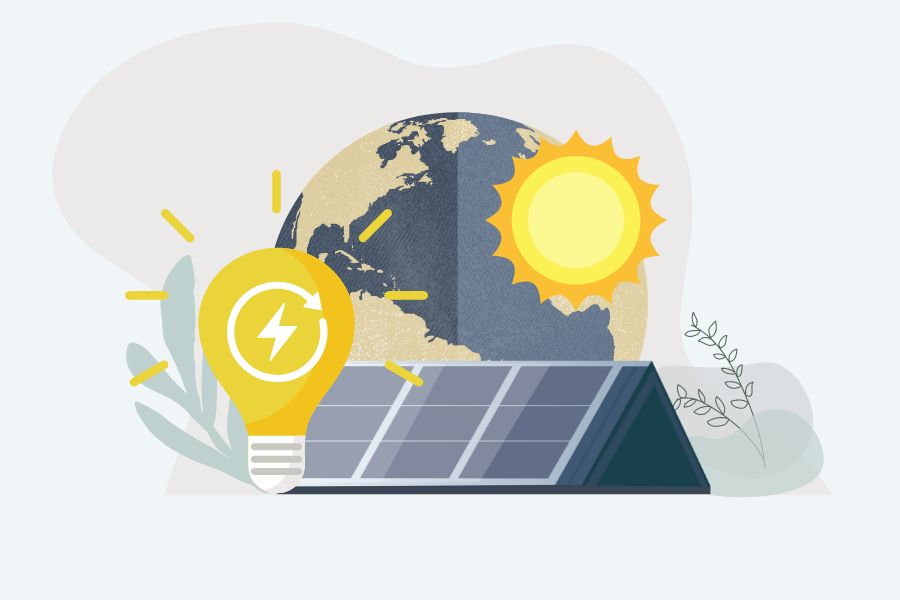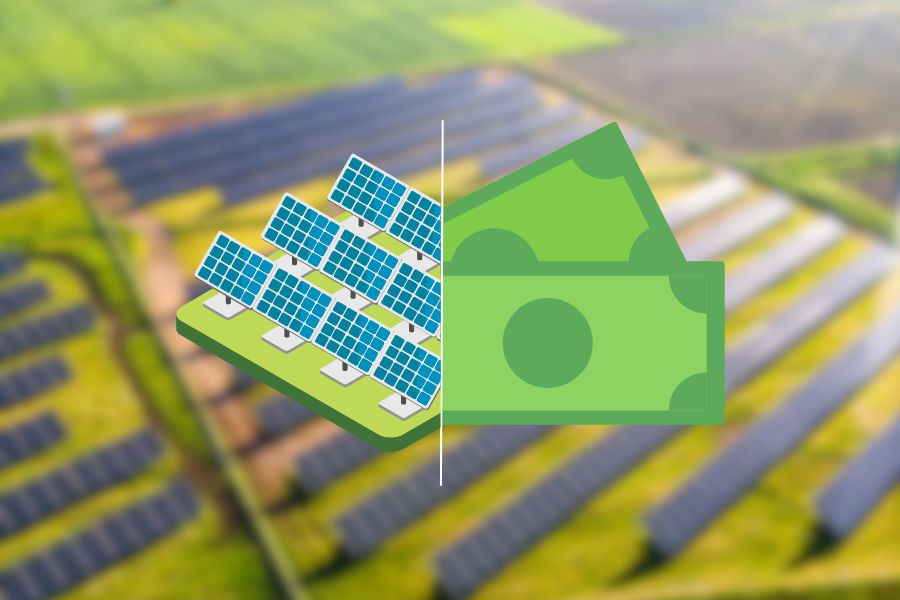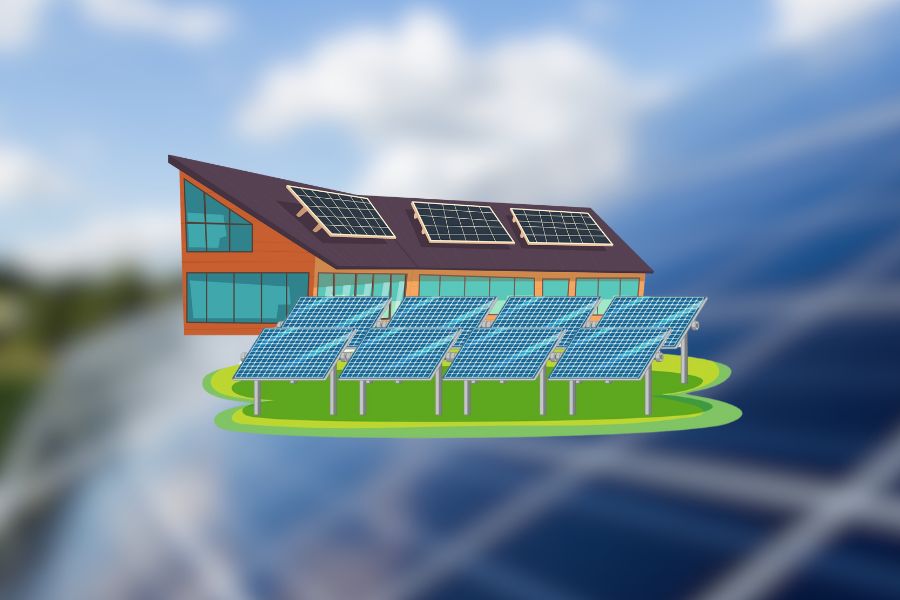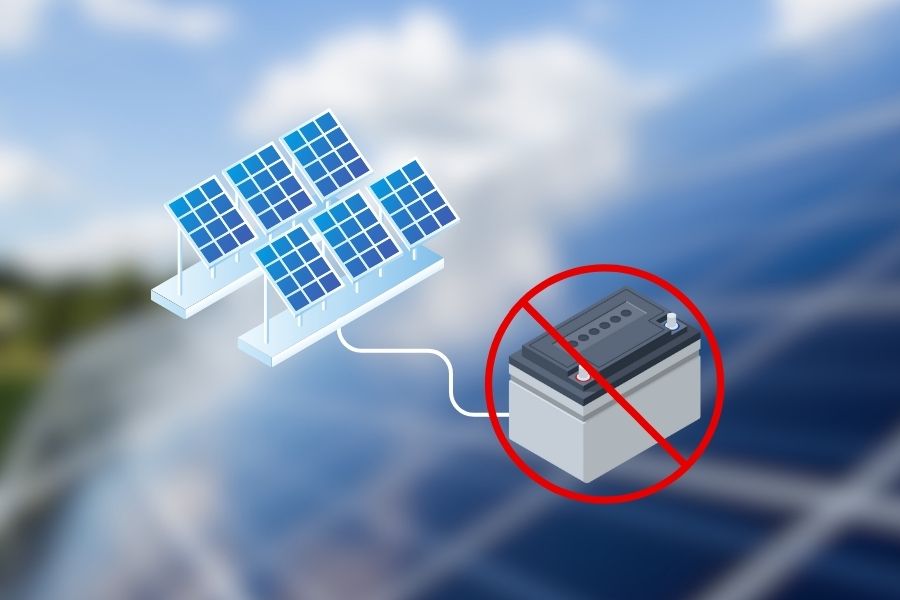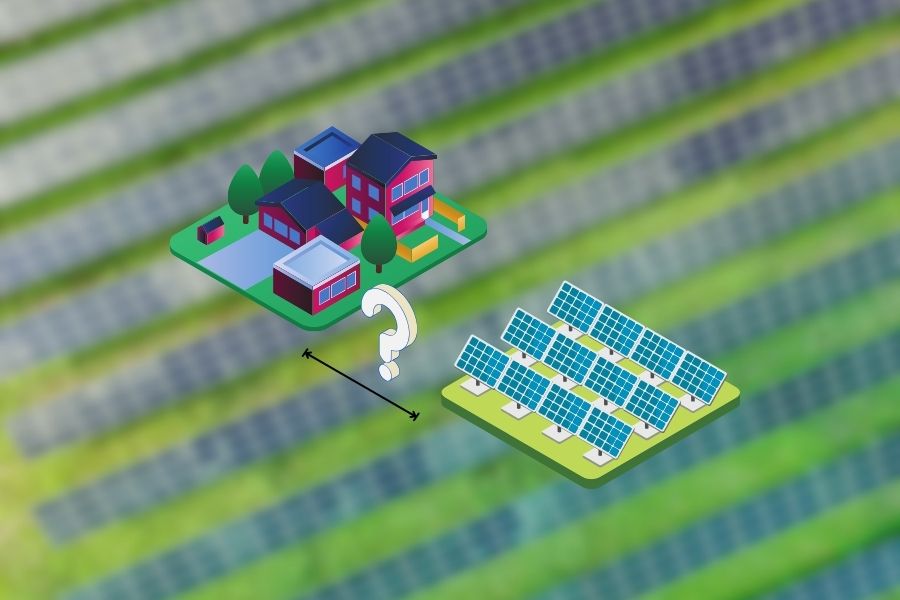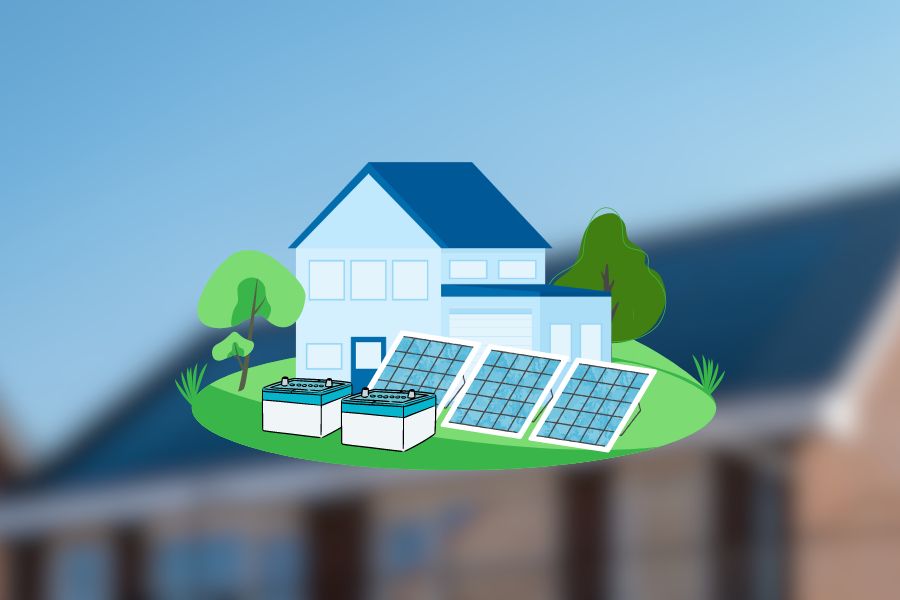Its geographical location and unique climate influences solar panel productivity in Ireland. Despite Ireland’s reputation for cloudy weather, a typical 1kW solar panel system can generate between 800 and 1,200 kWh annually.
Therefore, it’s estimated that a single 300W solar panel could generate roughly 0.8 to 1.2 kWh per day. This figure, of course, can fluctuate based on specific weather patterns, time of year, and panel orientation.
Ultimately, solar panels still offer substantial energy generation potential even in less sunny climates like Ireland.
How Much Electricity Does a Solar Panel Generate?

To quantify the energy generation of a solar PV panel, we typically use the unit of measurement called kilowatt-hours (kWh). A kilowatt-hour represents the amount of energy produced or consumed over one hour at a rate of one kilowatt.
On average, a typical residential solar system in a favorable location can generate between 250 to 400 watts per hour per square meter (W/m²) of the panel area. However, it’s important to note that this value can vary significantly based on the factors mentioned earlier.
For example, consider installing a 1 kW solar PV panel (1000 watts) in an area with good sunlight. Assuming the panel operates at its total capacity for 5 hours per day, it will generate 5 kWh of energy in a single day (1 kW x 5 hours). Over a month, this would result in approximately 150 kWh (5 kWh x 30 days).
Solar PV panels installed in arrays or systems of multiple panels can significantly increase overall energy generation. Additionally, advancements in solar technology continue to improve the efficiency and output of solar panels.
Remember that these figures are rough estimates and can vary based on specific circumstances. Therefore, consulting with a professional or using solar energy calculators is recommended. People who consider local weather patterns and other factors to determine the electricity a solar panel generates.
Factors That Affect the Amount of Electricity That Solar Panels Produce
Several factors influence the amount of power generated by a solar energy system. Understanding these factors is crucial for optimizing the performance and output of your solar panels. The key factors that affect the amount of power generated by a solar energy system include:
Solar Irradiance
Solar irradiance refers to the amount of sunlight that reaches the solar panels. Factors such as geographic location, time of year, and time of day influence it. Regions with higher solar irradiance receive more sunlight, generating more significant power.
Angle and Orientation
The angle and orientation of solar panels impact their efficiency. Solar panel installation happens at an angle that allows them to capture the maximum amount of sunlight throughout the day. They should face south in the northern hemisphere and north in the southern hemisphere for optimal sunlight exposure.
Shading
Shading from nearby objects, such as buildings, trees, or structures, can significantly reduce the power output of solar panels. Therefore, it is essential to ensure that panels are not shaded during peak sunlight hours to maximize energy production.
Temperature
Solar panels are sensitive to temperature variations. While sunlight is necessary for power generation, excessive heat can decrease the efficiency of solar panels. In addition, high temperatures can lead to a decrease in voltage and overall output. Therefore, one should keep the operating temperature of solar panels within an optimal range for efficient energy production.
Panel Efficiency
The efficiency of solar panels is an essential factor affecting power generation. Higher-efficiency panels can convert a more significant percentage of sunlight into electricity. However, the efficiency of solar panels can vary based on the technology used and the quality of the panels.
System Size
The size of your solar energy system, including the number of panels, will directly impact the amount of power generated. A more extensive system with more panels will produce more electricity than a minor solar system.
Maintenance and Degradation
Proper maintenance and regular cleaning of solar panels are essential for optimal performance. Dust, debris, or dirt accumulation on the panels can reduce efficiency. Additionally, solar panels may experience some degradation over time, slightly decreasing their power output.
Inverter Efficiency
Solar panels generate direct current (DC) electricity, which converts into alternating current (AC) for use in homes and businesses. Inverters are responsible for this conversion. Therefore, the efficiency of the inverter affects the overall efficiency of the solar energy system.
Average Solar Panel Output per Day (kWh) In Ireland
On an average sunny day in Ireland, a home solar PV system with solar cells sized at 20 sq. m (~3kW) can generate around 10-15 kWh of electricity daily.
Solar cells are the essential components of solar panels that convert sunlight into electricity through the photovoltaic effect.
It’s important to note that this estimation considers a specific system size and assumes favorable weather conditions. The actual solar panel output in Ireland can vary. That is due to solar irradiance, weather fluctuations, panel efficiency, shading, and other local requirements.
While this estimate provides a broad range, consulting with solar energy experts or installers is recommended to assess the specific factors relevant to a particular location in Ireland. They can provide more accurate calculations based on panel capacity, orientation, tilt angle, and local weather patterns.
How Much Energy Does a Solar Panel Produce Per Month?
For a residential solar panel system in a sunny location, an estimate to generate electricity can range from 100 to 200 kilowatt-hours (kWh) per month per kilowatt of installed capacity. For example, a 5-kilowatt solar panel system can generate approximately 500 to 1000 kWh monthly electricity.
It’s important to note that the actual energy production may vary due to seasonal variations, weather patterns, shading, and panel orientation.
Some months in Ireland may have more sunlight and longer days, resulting in higher energy production, while others may experience less favorable conditions, leading to lower energy generation.
How Do Solar Panels Work?
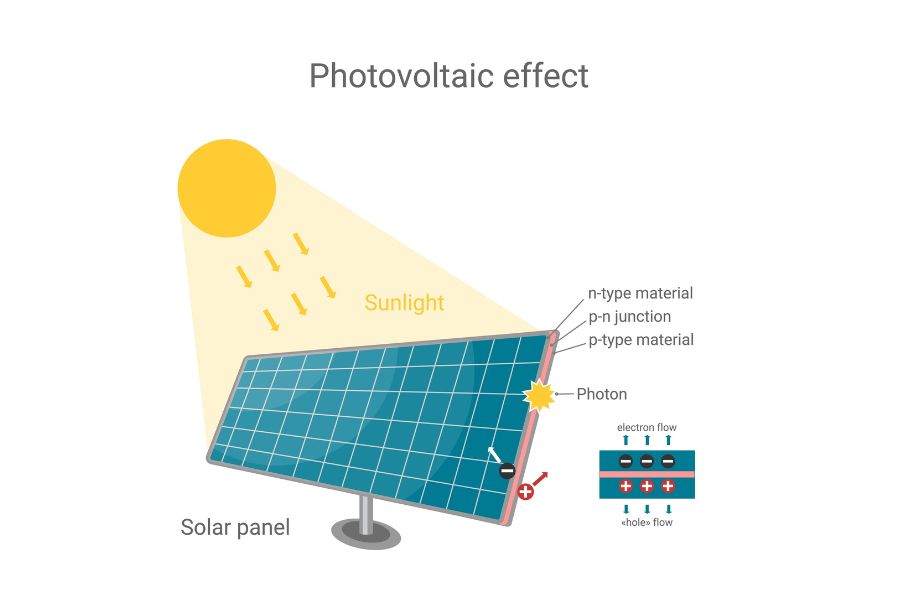
Solar panels, also known as photovoltaic (PV) panels, convert sunlight into electricity using the photovoltaic effect. The explanation of the basic working principle of solar panels can be as follows:
- Solar panels consist of multiple solar cells made from semiconductor materials, usually silicon. These cells are interconnected to form a module or panel.
- When sunlight hits the solar panel, photons (particles of light) strike the surface of the cells. The semiconductor material absorbs the energy from these photons.
- As a result, the absorbed energy excites the electrons within the semiconductor material, allowing them to break free from their atoms and create an electric current.
- The semiconductor material treatment helps it to create a built-in electric field within the cell. This field helps direct the freed electrons in a specific direction, thus creating a current flow.
- Metal contacts are placed on the top and bottom surfaces of the solar cell to collect this generated current and transfer it out of the panel.
- The solar cells’ direct current (DC) electricity is converted into alternating (AC) electricity using an inverter. AC electricity is the type of electricity used in homes and businesses.
- One can use the converted AC electricity to power electrical appliances and devices directly or feed it into the electrical grid for others to use. When it generates excess electricity, it can go into batteries for later use.
It’s worth noting that solar panels are most efficient when they receive direct sunlight. However, they can still produce electricity even on cloudy days, albeit at a reduced capacity.
9 Things That Affect Solar Panel Production

Sunlight Availability
The amount of sunlight that reaches the solar panels directly affects their production. Regions with more sunlight throughout the year generally have higher solar panel production. Conversely, cloudy or shaded areas will have reduced solar panel output.
Angle and Orientation
The angle at which solar panels installation happens relative to the sun’s position affects their production. The optimal angle varies depending on the geographic location. Panels should be oriented to maximize sun exposure, usually facing south in the Northern Hemisphere and north in the Southern Hemisphere.
Temperature
Solar panels operate less efficiently at higher temperatures. Excessive heat can cause a decrease in voltage and overall performance. Cooling mechanisms or proper ventilation can help maintain the panels at an optimal temperature.
Panel Cleanliness
Dust, dirt, leaves, or other debris on the surface of solar panels can reduce their efficiency. Therefore, regular cleaning of the panels helps maximize their production. In some regions, rain may be sufficient to keep the panels clean.
Shading
Shading on solar panels can have a significant impact on production. Even partial shading on a small portion of a panel can significantly reduce its output. Therefore, avoiding shading from nearby objects such as buildings, trees, or other structures is essential.
Panel Quality and Technology
The quality of solar panels and the underlying technology can affect their production. Higher-quality panels with advanced technologies tend to have better efficiency and performance. Investing in reliable and reputable brands is recommended.
Wiring and System Losses
Proper wiring and system configuration are essential to minimize losses in electricity transmission. High-quality wiring and appropriate system design help ensure maximum energy transfer from the panels to the inverter and, ultimately, to the electrical load.
Degradation Over Time
Over the lifespan of solar panels, they may experience a slight decrease in efficiency due to aging and degradation. However, this degradation factors into the panel’s performance warranty and most panels can maintain good production levels for several decades.
Geographic Location
The geographic location plays a role in solar panel production. Factors such as latitude, altitude, and local climate conditions affect the intensity and duration of sunlight available for solar panel production.
Understanding the specific conditions of the installation site is essential for estimating production.
How to Calculate How Many Watts a Solar Panel Produces
To calculate the power output of a solar panel in watts, multiply the panel’s rated capacity (in watts) by the average daily sunlight hours and the efficiency factor.
For example, a 300-watt panel with 5 hours of sunlight and 80% efficiency would produce 1,200 (or 1.2 kilowatt-hours) daily.
How Many Solar Panels to Produce 30 kWh per Day?
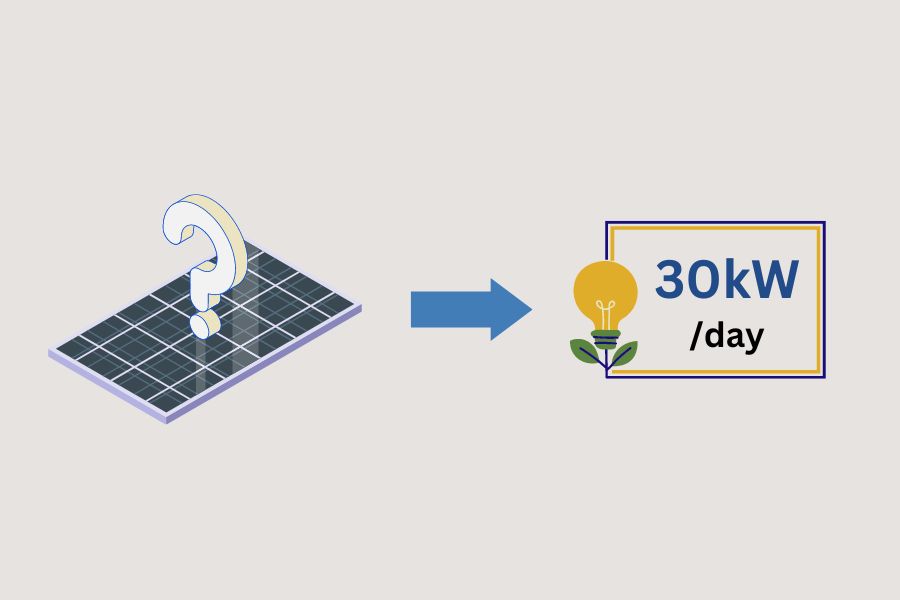
One must consider several factors to determine the number of solar panels needed to produce 30 kilowatt-hours (kWh) per day:
- Solar Panel Capacity: Determine the power of each solar panel in kilowatts (kW). The manufacturer typically provides this information.
- Sunlight Availability: Assess the average daily sunlight hours in your location. One can obtain this information from local weather data or solar energy resources.
- System Efficiency: Consider the efficiency of the solar panel system, accounting for factors such as wiring losses, temperature, and shading. Typical system efficiencies range from 80% to 90%.
Once you have these values, you can calculate the number of solar panels using the following formula:
Number of panels = (Required daily kWh) / (Panel capacity in kW Sunlight hours System efficiency)
For example, if each panel has a capacity of 300 watts (0.3 kW), and your location receives an average of 5 sunlight hours per day with an 85% system efficiency, the calculation would be:
Number of panels = 30 kWh / (0.3 kW 5 hours 0.85) = 23.53
You would need approximately 24 solar panels to produce 30 kWh daily under the conditions.
How Can I Increase Solar Panel Efficiency?
Select High-Efficiency Panels
Consider investing in solar panels with higher efficiency ratings. Advanced technologies, such as monocrystalline or polycrystalline panels, can offer better performance in converting sunlight into electricity.
Optimize Panel Orientation and Angle
Install solar panels at an optimal angle and direction to maximize exposure to sunlight. Adjust the tilt and orientation based on location to capture the most sunlight throughout the day.
Minimize Shading
Ensure that solar panels are free from shading, as even partial shading can significantly reduce their efficiency. Trim nearby trees or remove any objects that cast shadows on the panels.
Keep Panels Clean
Regularly clean the surface of the solar panels to remove dust, dirt, leaves, or any other debris that can obstruct sunlight. Clean panels can operate at their maximum efficiency.
Improve Ventilation and Cooling
Solar panels perform better at lower temperatures. Therefore, enhance ventilation around the panels to dissipate heat and keep them cool. One can achieve this by maintaining an appropriate gap between the panels and the mounting surface.
Use Tracking Systems
Install solar tracking systems that allow panels to follow the sun’s path throughout the day. These systems can optimize the angle of the panels and improve their efficiency by ensuring maximum exposure to sunlight.
Install Micro-Inverters or Power Optimizers
Instead of using a single inverter for the entire solar array, consider using micro-inverters or power optimizers. These devices optimize the performance of individual panels. That helps to minimize the impact of shading or mismatched panels.
Implement Energy Storage
Adding energy storage, such as batteries, allows you to capture and store excess energy generated by solar panels. It helps increase the overall efficiency by utilizing the stored energy during low sunlight or peak energy demand.
Regular Maintenance and Monitoring
Perform routine maintenance checks and monitor the performance of your solar panels. Promptly address issues such as faulty wiring, damaged panels, or system malfunctions to ensure optimal efficiency.
Conclusion
A solar panel’s daily kilowatt-hour (kWh) production depends on various factors such as panel capacity, sunlight availability, and system efficiency.
Considering these elements and performing the necessary calculations makes it possible to estimate a solar panel’s power output accurately. However, it’s important to remember that the actual kWh production may vary due to weather conditions, shading, and other factors.
You can maximize your solar investment by selecting high-quality panels, optimizing their orientation, keeping them clean, and maximizing system efficiency. As a result, you can enjoy a substantial daily kWh production contributing to a greener and more sustainable future.
